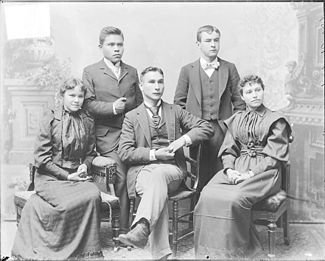How Did Native American Families Get Their English Last Names

During the last function of the nineteenth century the emphasis of the U.s. Indian policy was on assimilation. According to this philosophy, American Indians, only like other immigrants to the U.s.a., should digest into "mainstream" America. One of the concerns at this fourth dimension was the lack of surnames amongst Indians.
American Indians accept frequently noted that non-Indians have an obsession with private property. Government concerns with Indian surnames stems from this concern. The business for private property goes beyond the individual accumulation of property and includes the ability to laissez passer this property on to the property owner'due south descendents, thus helping to create family fortunes. Family unit lineages are an of import part of private property.
In 1887, the Congress passed the General Allotment Act (Dawes Act) with the intent of assimilating Indians by making them land-owning farmers. The idea of the Dawes Deed is to intermission upwardly the reservations by giving each Indian family unit an allotment of land, similar to the homesteads given to non-Indian settlers.
In breaking the reservations up into individually owned allotments, the first step was to put together a tribal roll. Regarding Indian names on these tribal rolls, Sioux physician Charles Eastman wrote:
"Originally, the Indians had no family unit names, and confusion has been worse confounded by the admission to the official rolls of vulgar nicknames, incorrect translations, and English cognomens injudiciously bestowed upon children in the various schools."
Government business concern for Indian names, particularly surnames, was directly continued with allotments. The allotments came under territory and state inheritance laws. All of these laws were based on Euro-American family relationships and therefore the upshot was confusion if an allottee died intestate and local officials had to determine the heirs.
In 1890, the Commissioner of Indian Affairs ordered Indian names on the reservations to be inverse so that each Indian would be given an English language Christian name and retain the surname. Surnames were to be translated to English and shortened if they were too long. Care was to exist taken to avoid translations of Indian names that might exist offensive to non-Indians. The new names were to exist explained to the Indians.
One of the ways of creating the new Indian surnames was to utilise the proper name of the male parent every bit the family proper name. This also meant that the Indian agents had to endeavor to terminate the traditional practice of assigning Indian names. This practice ignored the fact that many Indian nations were matrilineal, that is, a person belonged to the mother'south clan or family.
On some reservations, the Indian agent changed names such as Lone Deport to Lon Dark-brown, Night Horse to Henry Lee Tyler, and Yellow Calf to George Caldwell. On some reservations, Indians were given names such as "Cornelius Vanderbilt" and "William Shakespeare." Presidential names were also popular and then a number of Indians were named George Washington, Thomas Jefferson, Abraham Lincoln, and others.
On the Air current River Reservation in Wyoming, the Indian amanuensis reported that:
"Now every family has a name. Every begetter, mother; every husband and wife and children bears the last names of these people; now belongings goes to his descendant."
He as well reported:
"During my administration I took a demography of over ii chiliad names and had them all change, though it took over two years to accomplish the task."
In noting that Indians oft change names in response to events in their lives, Frank Terry, the Superintendent of the Crow Boarding School wrote in 1897:
"Hence it will exist seen that the Indian names are zero, a mirage, and a snare, and the exercise of converting them into English appears eminently unwise."
He also noted that the requirement to give Indians American-style names had not been uniformly carried out:
"While some accept made earnest efforts to carry out the wishes of the Section in this particular, others have treated the affair as i of fiddling or no concern. In many cases no attempt seems e'er to take been made to systematize the names of the Indians, and in many others where such attempt was fabricated the correct names for want of attending on the function of officers in accuse, have been forgotten or permitted to fall into disuse."
In addition to having the Indian agents requite Indians more "civilized" names, the government besides assigned new names to Indian students in both their boarding schools and in their day schools.
In 1890, the Commissioner of Indian Affairs published a detailed set up of rules for Indian schools. Schools were to give Indian students surnames so that as they could become belongings owners information technology would exist easier to ready lines of inheritance. Since most teachers could not pronounce or memorize names in native languages, and they did not understand these names when translated into English language, it was not uncommon to requite English surnames equally well equally English language first names to the students.
In the school established for the Quileute on the Declension of Washington, the schoolmaster gave the students names from the Bible and from American history.
Many Indian families today have stories almost how their parents, grandparents, and great-grandparents got their surnames. While the government intent was to eradicate the traditional names and naming procedures, what has instead resulted in many cases is a naming duality: the formal names with surnames that the government requires, and traditional names still given in the traditional ways.
Source: http://nativeamericannetroots.net/diary/1028
0 Response to "How Did Native American Families Get Their English Last Names"
Post a Comment